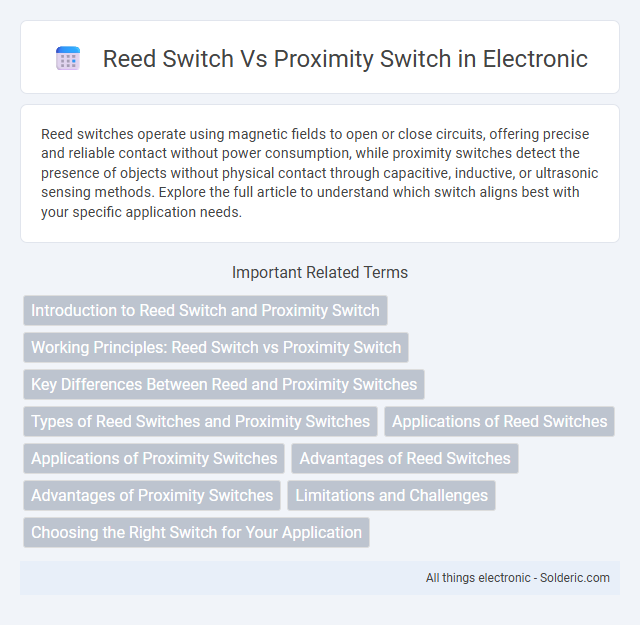Reed switches operate using magnetic fields to open or close circuits, offering precise and reliable contact without power consumption, while proximity switches detect the presence of objects without physical contact through capacitive, inductive, or ultrasonic sensing methods. Explore the full article to understand which switch aligns best with your specific application needs.
Comparison Table
| Feature | Reed Switch | Proximity Switch |
|---|---|---|
| Working Principle | Magnetic field actuated mechanical contacts | Non-contact sensing using electromagnetic fields or capacitive/inductive methods |
| Contact Type | Mechanical, normally open or closed | Solid-state, no physical contact |
| Sensing Range | Typically up to a few millimeters | Up to several centimeters (depending on sensor type) |
| Response Time | Milliseconds | Microseconds to milliseconds |
| Durability | Wear from mechanical operation over time | Long lifespan with minimal wear |
| Environment Suitability | Sensitive to vibration and shock | Resistant to harsh environments including dust and moisture |
| Power Consumption | No power required for sensing | Requires power supply |
| Output Type | Switching contact (open/close) | Digital or analog signal output |
| Typical Applications | Position sensing, security alarms, reed relays | Automation, proximity detection, object counting |
| Cost | Low cost | Moderate to high cost depending on type |
Introduction to Reed Switch and Proximity Switch
Reed switches consist of two ferromagnetic blades sealed within a glass tube that close or open an electrical circuit in response to an external magnetic field, providing reliable contact operation for low-current applications. Proximity switches detect the presence or absence of nearby objects without physical contact by using electromagnetic fields, capacitance, or inductance, making them ideal for non-contact sensing in industrial automation. Both switches serve distinct functions: reed switches excel in magnetic sensing with mechanical contacts, while proximity switches offer versatile detection methods for various materials and distances.
Working Principles: Reed Switch vs Proximity Switch
Reed switches operate using two ferromagnetic blades sealed within a glass tube that close when exposed to a magnetic field, enabling current flow. Proximity switches detect the presence of objects without physical contact by using electromagnetic fields, capacitance, or inductance changes depending on the type. Reed switches offer simple mechanical switching reliant on magnet positions, while proximity switches provide versatile sensing based on various physical field disruptions.
Key Differences Between Reed and Proximity Switches
Reed switches use magnetic fields to open or close contacts within a sealed glass tube, making them highly sensitive to magnetic proximity but limited in durability under mechanical stress. Proximity switches operate using electromagnetic or capacitive fields to detect objects without physical contact, offering greater versatility and longer lifespan in industrial applications. Your choice depends on the need for contactless detection and environmental robustness, with proximity switches preferred for more demanding or varied sensing conditions.
Types of Reed Switches and Proximity Switches
Reed switches primarily come in two types: normally open (NO) and normally closed (NC), with NO being the most common for detecting the presence of a magnetic field. Proximity switches include various types such as inductive, capacitive, ultrasonic, and photoelectric sensors, each designed to detect objects without physical contact based on different sensing principles. Inductive proximity switches detect metallic objects using electromagnetic fields, whereas capacitive sensors can detect both metallic and non-metallic materials by measuring changes in capacitance.
Applications of Reed Switches
Reed switches are widely used in security systems for door and window sensors due to their reliable magnetic field detection. They find applications in industrial automation for position sensing and flow monitoring, benefiting from their non-contact operation and low power consumption. Medical devices also utilize reed switches for their compact size and durability in detecting patient movements or equipment states.
Applications of Proximity Switches
Proximity switches are widely used in industrial automation for object detection, position sensing, and counting applications, where non-contact operation enhances durability and reduces wear. They are commonly implemented in conveyor systems, robotic arms, and packaging machinery to detect the presence or absence of metal or non-metal objects. Their ability to operate reliably in harsh environments with dust, dirt, and moisture makes them ideal for automotive assembly lines and material handling systems.
Advantages of Reed Switches
Reed switches offer advantages such as low power consumption, high reliability, and fast switching speeds, making them ideal for battery-powered and sensitive electronic devices. Their simple construction ensures durability and resistance to harsh environments, providing a long operational lifetime without mechanical wear. You benefit from precise, contact-based sensing with excellent noise immunity, suitable for applications requiring accurate magnetic field detection.
Advantages of Proximity Switches
Proximity switches offer contactless operation, reducing wear and extending device lifespan compared to Reed switches with mechanical parts. Their faster response times and higher switching frequencies enhance precision in automation and industrial applications. Proximity sensors also exhibit better resistance to environmental factors such as dust, moisture, and vibration, ensuring reliable performance in harsh conditions.
Limitations and Challenges
Reed switches face limitations such as mechanical wear, contact bounce, and sensitivity to magnetic field strength, leading to shorter lifespan and potential signal inconsistencies. Proximity switches, while more durable, often struggle with interference from environmental factors like dust, moisture, and metal target variability, which can affect detection accuracy. Both sensor types require careful application-specific consideration to mitigate these challenges and ensure reliable performance.
Choosing the Right Switch for Your Application
Selecting between a reed switch and a proximity switch depends on factors like operating environment, precision requirements, and power consumption. Reed switches offer reliable contact closure for low-power applications and simple mechanical actuation, while proximity switches provide non-contact sensing with higher durability and faster response times in harsh or dirty conditions. Evaluating these characteristics alongside application-specific demands ensures optimal performance and longevity in your switching solution.
Reed switch vs Proximity switch Infographic

 solderic.com
solderic.com